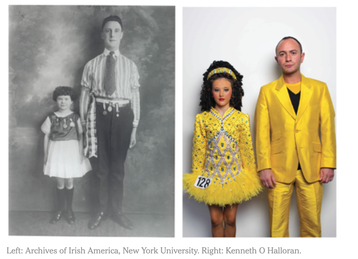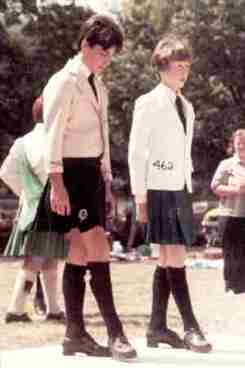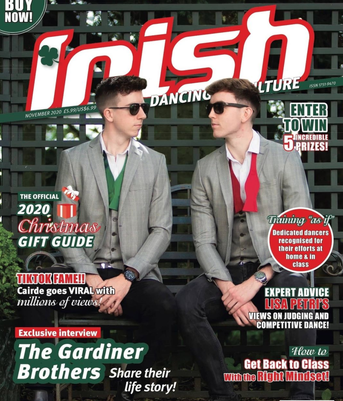 The early 1990s versus the early 2000s The early 1990s versus the early 2000s The Look, Part 4: Male Costuming Fashion, in or out of the dance world, has long been a female-dominated realm. However, while that means male Irish dancers have had significantly less changes over the years, they haven’t completely escaped the glamification of their costumes! Today we’ll take a look at that evolution and how our current expectation for male Irish dance costuming came to be.  Kilts were worn commonly into the 90s, especially as school costumes Kilts were worn commonly into the 90s, especially as school costumes While we know from our first installment (catch up here) that most Irish dancers started by dancing in their regular clothes, men’s costuming actually appears to predate women’s. Dance masters were typically male, and as they often dressed flamboyantly to help drive business, they were known by their fancy hats, swallowtail coats, breeches, white stockings/socks, and shiny, silver-buckled shoes. Due to British rules and restrictions (the impact of which was felt for 100s for years,) most male dancers simply wore their “Sunday Best” as their female counterparts did—typically a shirt and tie with breeches tucked into knee socks, a cummerbund around the waist. Similarly to female trends, as time passed there was a focus on traditional Irish fabrics and designs. For instance, in 1904, at the first Glens Feis in Glenarriff, Co. Antrim, the first prize for one of the competitions was: “a suit of Irish Homespun, presented by Hamilton and Co. Portrush, Co. Antrim.” While kilts as a male clothing item is associated in our modern minds with Scotland, Irish dance has always been about the feet, so kilts became a typical item dancers (male and female!) wore for many years (largely from the 1910s to the 1960s.) Pipers first wore them, but as Irish dance and music are completely intertwined, the dancers eventually adopted the look at well. (If you check our previous post about Irish dance shoes, you’ll find Ireland and Scotland are intertwined in many aspects of their dance traditions!) Kilts were typically worn with a short coat and brat/cape (the male version a bit shorter and usually attached to the front of the coat with a Celtic design brooch—they’re a holdover from times of rebellion,) along with shirt, tie, and knee socks. These days, boys still have the option to wear a kilt, but since premiere of Riverdance in 1994, pants have gradually become the norm. Male dancers typically wear long (black) pants (though very young dancers sometimes perform in short pants,) a shirt, and often a vest and tie. For many years, it was a trend for male dancers to emulate the sparkling, bright dresses of the female solo dancers through their vests and ties. However, in recent times there’s been a movement toward more sleek, sophisticated looks rather than full on sparkle all the time!  The Gardiner Brothers’ viral tiktoks have influenced a more cool, casual look for male Irish dancers in the last few years (doesn’t hurt they have 5 World Championships between them!) The Gardiner Brothers’ viral tiktoks have influenced a more cool, casual look for male Irish dancers in the last few years (doesn’t hurt they have 5 World Championships between them!) And that’s a wrap on our series all about the whys and hows of Irish dance’s iconic look came to be! One of the most exciting things about being part of the Irish dance community is just that—it’s a community that is growing and evolving, changing as its influence spreads across the globe. You don’t have to be Irish to do Irish dance, but by entering the world of Irish dance you’re becoming a part of a living tradition that both honors the past while moving forward into the future. Through wigs, kilts, and beyond! This post is part of a series. Take a look at our last “Origins of Irish Dance” post, all about modern female costuming, here. Also: check out the blog every Monday and Thursday for more posts about Irish history, dance culture, community news, and spotlights on our dancers, staff, and families—among other fun projects! And don’t forget to dance along with us on both Facebook and Instagram.
0 Comments
Your comment will be posted after it is approved.
Leave a Reply. |
SRL NewsFind all of our latest news on our Scoil Rince Luimni Facebook page! Categories
All
Archives
August 2022
|
 RSS Feed
RSS Feed